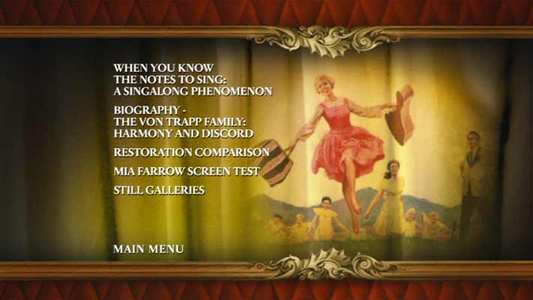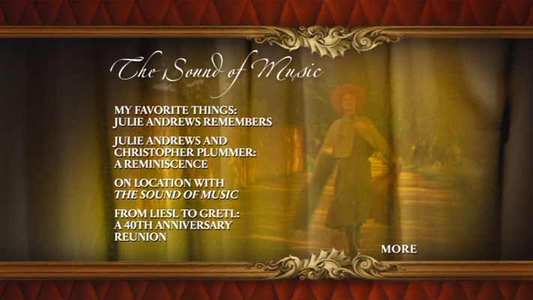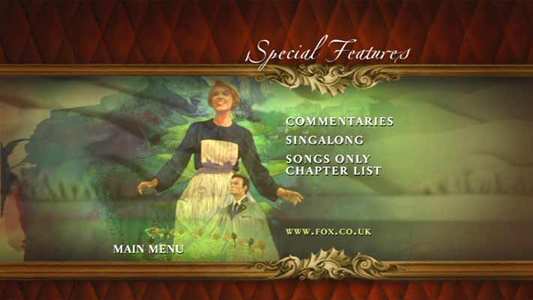Review of Sound Of Music, The (Special Edition) (Two Discs)
Introduction
The Sound of Music. The hills are alive with it. Apparently. The movie is the signature picture of the 1960s, a family-friendly romp through annexed Austria in the late 1930s. Sound of Music has everything - songs, adorable children, a slightly whacky heroine, nuns and hissable Nazi villains. While many commentators at the time regarded the movie as saccharine and corny, it touched a nerve with its audience. It was one of the first movies to gain a fanbase who went to see it repeatedly (and this in an era without home video).
Okay, let`s start at the very beginning (a very good place to start). Directed by the late Robert Wise, The Sound of Music was the most successful of the late-period musicals (including My Fair Lady, Oliver!, et al.) in fact, between 1965 and the advent of blockbusters such as Jaws and Star Wars, The Sound Of Music was the most successful box-office picture of all time. The musical was based on the true story of the Von Trapp family singers, who became fixtures on the American folk music circuit after their flight from the Anschluss. The last work (1959) of Oscar Hammerstein II, who had enjoyed a highly successful career writing Broadway musicals with Richard Rodgers, the musical was also the last of the Rodgers and Hammerstein collaborations to be filmed. On Broadway, the musical had run for 1443 performances, winning eight Tony awards. The stage Maria - the story`s postulant nun heroine - was played by Larry Hagman`s mum, stage actress Mary Martin, playing opposite Theodore Bikel as the Captain. By the time SOM reached the screen, younger actors were in the frame for the roles. When Fox paid $1.25million for the screen rights against 10% box office gross in 1960, the name initially attached to the movie to play Maria was Doris Day. It would take another four years for the project to reach the shooting stage.
The movie was planned from the start as an event picture (even before summer blockbusters were invented). It was shot in the cumbersome but spectacular TODD-AO 65mm format (printed up as 70mm with six-track magnetic sound). Robert Wise, who had been preparing war epic The Sand Pebbles for Fox, was experiencing script and location problems with that movie and signed up to direct the movie from Ernest Lehmann`s script. Wise brought on board his associate producer Saul Chaplin and designer Boris Leven. Irwin Kostal arranged and conducted the score, which included two newly-written songs (I Have Confidence and Something Good) by Richard Rodgers.
Among the extensive crew for the movie were some pedigree Hollywood names. William Reynolds, who had cut Wise`s The Day The Earth Stood Still and most of the Fox Rodgers and Hammerstein musicals edited the picture. The sound crew included Murray Spivack, who had made King Kong grunt back in 1933. L.B. Abbott, one of the great photographic effects men headed that department and the movie was photographed by East of Eden and Treasure of the Sierra Madre cinematographer Ted McCord. Choreographers Marc Breaux and DeeDee Wood, fresh from Mary Poppins, would go on to put Dick Van Dyke through his paces again for Chitty Chitty Bang Bang.
Julie Andrews, who had lost the role of Eliza in My Fair Lady to Audrey Hepburn in spite of playing the role on stage, was riding high on the consolation of nailing the role of Mary Poppins. Signing up as Maria, she would make the second signature performance of her career in the space of two years. She was joined by Christopher Plummer as the irascible Captain Von Trapp (his singing voice would be dubbed by singer Bill Lee for the final release), and seven child actors for whom the movie was the first step of a career before the camera for three of them.
Charmian Carr played Liesl, the eldest. She had got the role over other better known actresses including Mia Farrow, who had screentested for the part. A whole marketing campaign was put together by Fox publicists for her, including a Salzburg travelogue that was included with the old DVD edition (so if you have a copy, don`t eBay it yet!). Sadly, the movie was her only claim to fame, although she appears in the extras none the worse for her experiences. Next eldest was Friedrich, played by Nicholas Hammond, who would go on to play Spiderman for television and who is still active in the Hollywood game. Heather Menzies played Louisa. She would go on to a very active career in television including the tv version of Logan`s Run. She is the widow of tv tough-guy Robert Urich and nowadays works in partnership developing ideas in Hollywood with her screen sister Brigitta from Sound - Angela Cartwright. Cartwright was possibly the most seasoned professional of the lot, fresh from a three year run of Lost In Space playing Penny Robinson. She is also, alongside Nicholas Hammond, the most successful in Hollywood beyond the movie of the seven children. Duane Chase played Kurt. He`s now in IT. Second youngest of the children was Debbie Turner as Marta. She had so much trouble with loose teeth during the production she had to be fitted with dentures for the sake of continuity. Smallest of the group was five-year-old Kym Karath, who was already a seasoned movie actress having worked opposite Doris Day in The Thrill Of It All.
Casting the children had been a nightmare, and as well as Mia Farrow, Kim Darby had tested for Liesl. Veronica Cartwright (Angela`s older sister and victim-to-be of both the Alien and the Witches of Eastwick) tested, and among the boys, Kurt Russell, Richard Dreyfuss and the four eldest Osmonds tried out for the role. Dreyfuss claims he lost the role because he couldn`t dance.
Watch out for Marni Nixon playing Sister Sophia, by the way. She dubbed Audrey Hepburn`s singing voice for My Fair Lady, Natalie Wood for West Side Story and Deborah Kerr for The King And I and An Affair To Remember.
In April 1964, principal photography began in the Salzkammergut region of Austria. Nearly half of the movie was a location shoot and in spite of appalling weather, the shoot wrapped two months later to reconvene at Twentieth Century Fox in Los Angeles where the interiors were to be shot. August 20th 1964 saw the completion of the movie at a final budget of $8.4million and the movie premiered on March 2nd 1965 at New York`s Rivoli Theatre.
The Sound Of Music was to take $163million at the box-office and an unassailable place as the most successful motion picture ever made until it was supplanted by Jaws in 1975.

Video
The previous DVD was mastered from a print struck in 1993, and which in comparison with the newest print lacks definition, is milky, oversharpened, overly dark, and suffering from a distinct blue bias. All in all it looks like it was made to master VHS tapes from. Unfortunately there are a lot of folk on the web who have seen comparisons between the 1993 and 2005 restorations and who have voiced a preference for the earlier transfer.
They could not be more wrong.
The new transfer is, most importantly, originated from the original 65mm negatives. Most of the restoration has been completed in the photochemical domain, with new fine grain internegatives being produced. The movie has been virtually rebuilt, with great pains taken to make the movie look as good as it did back in 1965. Restoration on film continues to be the best method for ensuring the continued preservation of precious movies, and the work carried out by Fox and the Academy of Motion Picture Arts and Sciences will ensure that this movie will see its centenary if the rest of us don`t.
The digital transfer of the movie was carried out at high definition. The importance of carrying out restoration on film is that as long as the movie is available in its native format, that can be happily transferred to whatever new medium comes along at whatever (higher) definition. If the movie was only available as a 2K digital file, where would you be if you needed a high-definition source?
The transfer, while some film artefacts remain apparent (and in fact some have been made more apparent by the high-def transfer), has never been better. Colours are rendered truer and the contrast range is much better. When you do a side-by-side comparison between the older DVD and the new one, the improvements are as marked as the restoration demonstration on the extras disc - Captain Von Trapp`s jacket was never blue with grey trim, it was always grey with green trim. Strikingly, the strange brightness-pumping of the titles as they faded in and out has gone.

Audio
The sound has been remixed to Dolby Digital 5.1 to give a closer reproduction of the six-track Todd-AO presentation of the movie in theatres. Although this should be listed among the extras, the partial Robert Wise commentary track and singalong isolated score track from the previous edition of the DVD has been included in this release as well as the new commentary track from Julie Andrews and that old reprobate Christopher Plummer (who still refers to the picture as "The Sound of Mucus")

Features
The movie disc is refreshingly free of clutter to allow the maximum bandwidth for the movie and its multiple soundtracks. There is, as previously mentioned, a commentary track by director Robert Wise. He clams up every time a song comes up to be replaced by the original accompaniment tracks so the audience can indulge in that singalong experience. The disc has an introduction by Julie Andrews from the Twentieth Century Fox lot in Hollywood.
The extras disc is again introduced by Julie Andrews. There is an hour-long retrospective documentary about the Sound of Music phenomenon entitled "My Favorite Things" which is quite fascinating. Julie Andrews and Christopher Plummer have a "reminiscence" in a second featurette, then Charmian Carr takes us "On Location With The Sound Of Music", latching on to one of Salzburg`s popular movie-themed tours. "From Liesl to Gretl: A 40th Anniversary Reunion" is a 30 minute reunion for the actors and actresses who played the Von Trapp children. It has to be said it isn`t a patch on ITV`s "After They Were Famous" episode that covered the movie.
One of the highlights of the extras disc is "When You Know The Notes To Sing", a short presentation about the Singalongasound of Music phenomenon, going behind the scenes of the movie`s special 40th Anniversary singalong performance at the Hollywood Bowl. The experience is described as "The Rocky Horror Picture Show on Prozac", and they aren`t kidding as people turn up for the event in lederhosen and dirndls. There are a number of nun drag-queens and even one bloke who turns up as the carburettor the nuns steal out of the SS staff car while Maria and the family are fleeing Austria.
Last of the documentaries is "The Von Trapp Family: Harmony and Discord", a fifty minute piece about the real Von Trapp family.
One strangely creepy extra, and this is no criticism of the actress in question, is Mia Farrow`s black-and-white screentest for Liesl. It comes in two parts - a quick demonstration of her dancing ability, which looks like what she remembered from ballet lessons as a child, and a quick warble of a line and a half of one of the songs before she`s cut off by the director.
The extras are rounded off with extensive galleries of storyboards and behind-the-scenes photos.

Conclusion
This picture has been with me my whole life. We`re roughly the same age and roughly the same condition (I was recently reprinted on mylar safety stock myself). I still think the movie could have worked without the post-wedding fleeing-the-Nazis stuff and I still get misty-eyed at "Climb Every Mountain". I don`t class it as the best musical ever made (that honour remains forever Singin` In The Rain), but it`s pretty damn close.
Your Opinions and Comments
Be the first to post a comment!